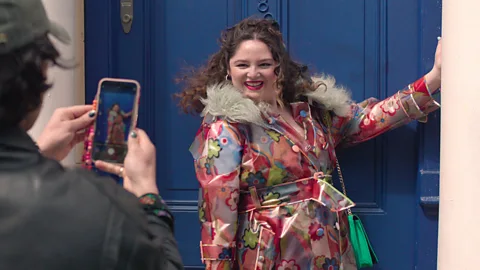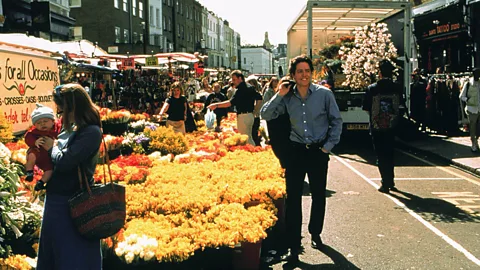Too Much: What film and TV get wrong about London
 Netflix
NetflixFilms and TV shows have created a glamorous "Notting Hill" version of the UK's capital city. A new Lena Dunham series pokes fun at the stereotypes Americans believe about the country.
When Jessica, the heroine of Lena Dunham's new series, Too Much, first arrives from New York to live in London, she thinks she's heading to live on a country estate; the idyllic Jane Austen or Bridgerton-era kind she's seen on screen. Instead, Jessica (played by US comedian Megan Stalter) is dropped off on an East London council estate (a block of social housing). So begins another tale of a young American discovering Europe, but unlike Emily in Paris, packed with dazzling locations and couture outfits, Jessica discovers vast housing projects, grimy pubs and sweaty gigs. Does this series show the reality of modern London?
Since the 1990s, some of the most successful British films set in London have presented the so-called "Notting Hill" version of the city; a name stemming from the eponymous 1999 Richard Curtis film starring Hugh Grant, Julia Roberts and Rhys Ifans. It glamourised the area, whose colourful houses still draw a steady stream of tourists and Instagrammers (to the extent that frustrated residents started painting them black and grey.)
Curtis also wrote the romcoms Bridget Jones's Diary, Four Weddings and a Funeral and Love Actually, which he also directed. These films, alongside the successful Paddington franchise of the last decade, have depicted a more idyllic, upper-middle-class version of the capital, its characters often living in West London's stucco-fronted houses. Recent hit Netflix series such as The Crown and Bridgerton have also shown off the city's grandest landmarks.
 Alamy
AlamyOf course, London has been portrayed in different ways throughout cinema history, including its bombed-out ruins after World War Two, in films such as 1949's Passport to Pimlico. The city's edgier side has been evident in cult classics such as Stanley Kubrick's A Clockwork Orange (1971), featuring a brutalist housing estate in Woolwich, or 1987's Withnail and I, shot in Notting Hill and Camden, home to the protagonists' legendary squalid apartment. Performance, a 1970 gangster drama directed by Nicolas Roeg and starring Mick Jagger, was also set in a crime-ridden Notting Hill of the time. Most recently, the hit Apple TV+ series Slow Horses, starring Gary Oldman as the head of a group of MI5 misfits, has been filmed in urban East London.
However, international recognition of films such as Notting Hill, Four Weddings and a Funeral and Bridget Jones remains high, 30 years after some of them were made. Notting Hill is regularly named by critics as one of the best romantic comedies ever made, as is Four Weddings and a Funeral. These stories have also been enormously successful at the box office – the Bridget Jones series of films has made just under $1bn worldwide, the Paddington films nearly $750m.
So, it's little wonder that new arrivals to London might have a romanticised idea of the city. Canadian comedian Katherine Ryan, now a Londoner, confessed at the world premiere of Too Much that she'd also thought of the British capital differently before arriving.
"When I first came to London, I had a similar experience to the character of Jessica," she tells the BBC. "Abroad, we just hear about Buckingham Palace and places like that. I was moving somewhere that had 'mansions' in the title and it was a flat. I thought Lena [Dunham] did a beautiful job of capturing that experience."
Too Much mainly uses locations that only Londoners, or those who've lived there, will know well: areas such as Shoreditch, Hackney, Hoxton, De Beauvoir town, Camberwell and Nunhead. "It's so grey over there," observes Jessica's mother (played by Rita Wilson) on a video call from the US. "I thought it would be so creative over there and I'd be jealous. But I'm not jealous."
Poking fun at stereotypes
Lena Dunham, who wrote the series, moved to live in London in 2021. She tells the BBC that Too Much is based on the contrast between her own heightened expectations of the city, and what she discovered by actually living there. "I want people to see what I did when I first arrived, which is what I knew from the movies," she says. "That's the Notting Hill version, those refined old buildings."
Dunham adds that she took a similar approach with Girls, the landmark HBO series she also starred in, about four twenty-something young women living in New York City in the 2010s. "I loved Sex and the City, but with Girls I wanted to show parts of New York that felt more real to those who couldn't afford massive apartments," she says. "And I wanted to do the same with London. So we do shoot in a manor house, but we shoot on council estates, in record stores and music venues all over London. We really take a journey."
 Netflix
NetflixIn fact, Too Much mocks the stereotype of Notting Hill in one episode (titled Notting Kill) as Jessica attends a dinner party thrown by her boss, played by Richard E Grant, and his wife, played by Naomi Watts. Jessica gets a photo at the famous blue door, where Hugh Grant's character lived in the film ("I'm Julia Roberts, bitch!" she squeals.)
Too Much also pokes fun at the tropes Jane Austen-era dramas have created. In one scene, Jessica's love interest Felix (Will Sharpe) makes a romantic overture and is briefly transformed in her eyes into 19th-Century military costume, with red jacket and tight white breeches. In doing this, Too Much makes a nod towards the production company behind the series: Working Title. Its producers, Tim Bevan and Eric Fellner, were behind Notting Hill, Love Actually and Bridget Jones's Diary. Working Title also produced the 2020 film version of Jane Austen's novel Emma and has announced it's making a new version of Sense and Sensibility.
"It's pretty meta what happens in the show, considering I produced most of the movies we're taking the mickey out of," Tim Bevan tells the BBC. He describes the series pitch of "an American coming expecting Pride and Prejudice and Richard Curtis, and getting something else altogether" as "a very easy sell. I'd always wanted to do something on how there is this delicious potential culture clash".
"In our work over the years, we've always tried to pick London to film in, and no one has done it on a big, big scale recently, in a loving way, to introduce a modern London." He adds: "I guess Too Much is prescribed as the antidote to Emily in Paris."
 Netflix
NetflixAnd although Emily in Paris has been criticised by some for pandering to an American vision of a chic, Chanel-wearing French capital, the show's economic benefits to France have been praised by President Macron: the series, as well as another French-language Netflix drama, Lupin, was cited in a recent French study as inspiring 1 in 5 tourists coming to Paris. And it's not just a recent phenomenon; the 2001 Oscar-nominated film Amélie, set in the Montmartre district of Paris, inspired a generation's perception of Parisian style and romance.
In New York in the 00s, Sex and the City, the story of the love lives of four glamorous Manhattan women, was credited with helping to restore the city's image after the devastation of the 9/11 attacks on the city, while the 1990s sitcom Friends, also set in New York, has inspired a new generation of Gen Z visitors longing for the cosy (and even 30 years ago, suspiciously affordable) West Village neighbourhood it presented.
Bevan says he too has personal experience of how powerful film and series have become in shaping a modern city's image. "I live in Notting Hill," he says, "and the real locations [used in the film] still bring millions of people every weekend. Location tourism is really huge; hopefully Too Much will mean some weird pub in East London will be suddenly inundated from all over the world."
A loving tribute
"There is an element now of whatever you depict on screen, it's going to glamourise it," film historian Pamela Hutchinson tells the BBC. But she argues that the film Notting Hill wasn't simply presenting the glossier side to the neighbourhood when it was made in the 1990s.
"That part of London was a place that was quite affordable in many ways but was also still quite aspirational. There was a certain amount of both glamour and diversity. I think what the movie got right was the idea that in this urban area where everyone's crowded together, a book shop owner can really meet a movie star. And the beauty of its architecture really shines through in that film.
"Of course, it also had a way of making the world and his wife decide it was the most glamorous area of London they could possibly move to."
Nor is Too Much the first piece of on-screen fiction to, as Hutchinson says, "play with the idea that you move to London because you've seen Notting Hill, but when you arrive, you're actually in a Mike Leigh film."
She points to Danny Boyle's 1996 film Trainspotting, in which the characters go to London, "and they have the idyllic idea of the city being about double decker red buses and Trafalgar Square. Then they crash you into Mile End in East London and show you that they're having to work in a terrible estate agency, living in a cramped flat, run by a ruthless landlord. It's honest about the vision of London with red buses and Tower Bridge in every film."
Too Much might explore the stereotypical nature of international perceptions about London, but at its heart, Dunham says it's also a tribute to the place she now definitely thinks of as hers. "I've been in New York getting ready to make a film, and I came back [to London] a couple of days ago and I had a strong feeling of peace that I was at home. To come from the place that was my home for so many years and to feel a little bit like a stranger there and return to London and feel that my life is here – I'm in the right place. Thank you for having me, England."
Too Much is on Netflix from 10 July.
--
If you liked this story, sign up for The Essential List newsletter – a handpicked selection of features, videos and can't-miss news, delivered to your inbox twice a week.
